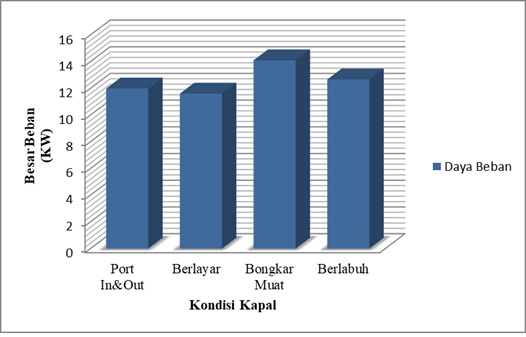Analysis of Electric Power Use in KM. Jaya Utama 66 Based on Electric Balance BKI
DOI:
https://doi.org/10.62012/zl.v4i3.30818Keywords:
Abstract
Jaya Utama 66 is a fishing vessel that operates in the sea waters of Maluku to Merauke. Analysis of the demand for electric power in KM. Jaya Utama 66 to prevent blackout conditions when the ship is operating and in selecting a generator as a source of ship power generation is very necessary. The purpose of this practical work is to know the working principle of the generator, to know the electricity distribution system and to be able to analyze the use of electric power in KM. Jaya Utama 66. Based on data obtained from observations and collection of equipment power loads on KM. Jaya Utama 66, the generator set has the principle of a rotor that rotates in a magnetic field and creates an electric force (EMF). Electromotive force is an electric action produced by a non-electric source. Electrical distribution system in KM. Jaya Utama 66 is sourced from the generator and then flowed to the main switch board and distributed to the connecting panel, then the electric power is divided between the loads of electrical equipment. The calculation results show that the ratio of Power consumption equipment is 80% with the Divercity Factor value according to the conditions of in&out ports, sailing, loading and unloading, and berthing above 0.50 and the Generator Load factor in ship operations is still feasible and according to the standards set by BKI which cannot be more of 80%.Downloads
References
S. Bahriyanto, Sugiyanto, B. Soepeno, R. P. N. Puji, J. R. Triyanto, and G. Prasetyo, “Development of Mayangan Fishing Port as Probolinggo’s Tourism 2012-2019,” J. Hist., vol. 5, no. 1, pp. 204–227, 2021.
A. Nurdin, “Analisis Kerja Generator LISTRIK,” no. 173, 2018.
F. Tawurisi, G. M. C. Mangindaan, and S. Silimang, “Rancang Bangun Sistem Kendali Automatic Transfer Switch Perusahaan Listrik Negara Generator Set,” J. Tek. Elektro dan Komput., vol. 8, no. 3, pp. 143–152, 2019.
M. R. Swastika, I. Susanto, and G. G. R. Gunadi, “Manajemen Perawatan Generator Set 6BT5.9-G2 Cummins Di Workshop Alat Berat Politeknik Negeri Jakarta,” Pros. Semin. M. R., Susanto, I., Gunadi, G. G. R. (2022). Manaj. Perawatan Gener. Set 6BT5.9-G2 Cummins Di Work. Alat Berat Politek. Negeri Jakarta. Pros. Semin. Nas. Tek. Mesin Politek. Negeri Jakarta, 1088–1092.ar N, pp. 1088–1092, 2022.
Muslimin Syam, “‘ Distribusi Daya Listrik di Kapal ’ A . M . Muslimin Syam PROGRAM STUDI TEKNIK SISTEM PERKAPALAN,” 2016.
D. Faturachman, “Studi Literatur Tinjauan Penggunaan Generator,” J. Sains Dan Teknol., vol. IV, no. 1, pp. 80–91, 2020, [Online]. Available: http://www.jurnalairaha.org/index.php/airaha/article/view/103/86
A. P. Putra, S. Suprayogi, and A. Qurthobi, “Studi Perhitungan Ggl Output Generator Arus Searah Berdasarkan Ilustrasi Gerak Transversal Gelombang Laut,” eProceedings Eng., vol. 5, no. 3, pp. 5986–5992, 2018.
A. Alimuddin and H. Herudin, “Analisa Efisiensi Konsumsi Energi Listrik Pada Kapal Motor Penumpang Nusa Mulia,” Setrum Sist. Kendali-Tenaga-elektronika-telekomunikasi-komputer, vol. 3, no. 1, p. 54, 2016, doi: 10.36055/setrum.v3i1.499.
R. Sarno, M. Pudjiantara, and B. Amaliah, “RANCANG BANGUN PERANGKAT LUNAK UNTUK SISTEM DISTRIBUSI LISTRIK DI KAPAL,” Teknol. Inf., vol. 3, pp. 85–92, 2004.
B. Sakti and T. Nurhayati, “Analisa Kebutuhan Daya Listrik Kapal KM. Sabuk Nusantara 92 Dengan Electric Balance BKI,” pp. 0–7, 2020.
T. A. K. Wardhana, ANALISIS TIDAK BEROPERASINYA EMERGENCY GENERATOR GUNA MENCEGAH BLACKOUT DI ATAS KAPAL MV.TANTO EXPRESS. 2022.
W. N. A. Wahid, “Tidak Bekerjanya Diesel Generator Yang,” 2019.
Suyanto, “penentuan electric balance BKI Vol. IV Tahun. 2004,” teknik, pp. 6–29, 2017.

Downloads
Published
How to Cite
Issue
Section
License
Copyright (c) 2023 Mohamad Haris, Jozua Ch Huwae, Fahriadi Pakaya, Yurika Nantan

This work is licensed under a Creative Commons Attribution 4.0 International License.
Allow anyone to modify, improve, and make derivative works, even for commercial purposes, as long as they credit to you for the original work.




























